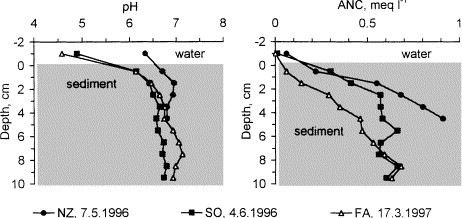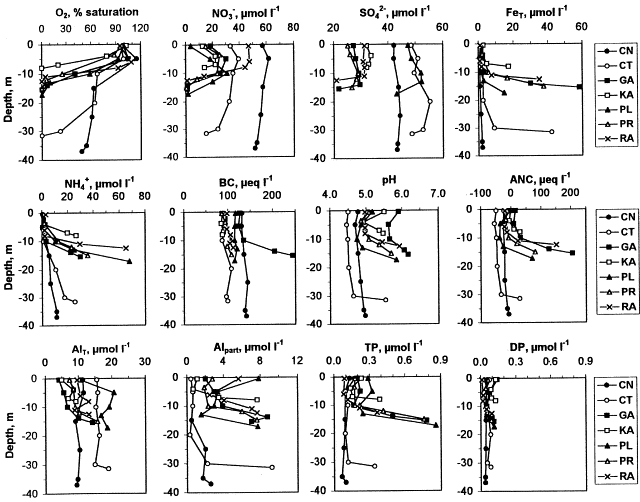 Atmospheric acidification of catchment–lake ecosystems may provide natural conditions for the in-lake control of P cycling. This process is based on the elevated transport of aluminum from acidified soils and its subsequent precipitation in the water body and is described for strongly acidified forest lakes, acidified and circumneutral reservoirs, and a moderately acidified alpine lake. In water bodies with episodically or permanently acidified inflows a pH gradient develops between lake water and tributaries due to: (i) neutralization of acidic inflows after mixing with waters with undepleted carbonate buffering system, and/or (ii) the in-lake alkalinity generation dominated by biochemical removal of NO3− and SO42−. With the pH increasing towards neutrality, ionic Al species hydrolyze and form colloidal Al hydroxides (Alpart) with large specific surfaces and strong ability to bind orthophosphate from the liquid phase. Moreover, Alpart settles and increases the P sorption capacity of the sediment. The presence of Alpart on the bottom reduces orthophosphate release from sediments after its liberation from ferric oxyhydroxides during anoxia because Alpart is not sensitive to redox changes. Consequently, the natural in-lake P inactivation may be expected in any water body with elevated Al input and a pH gradient between its inlet and outlet.
Atmospheric acidification of catchment–lake ecosystems may provide natural conditions for the in-lake control of P cycling. This process is based on the elevated transport of aluminum from acidified soils and its subsequent precipitation in the water body and is described for strongly acidified forest lakes, acidified and circumneutral reservoirs, and a moderately acidified alpine lake. In water bodies with episodically or permanently acidified inflows a pH gradient develops between lake water and tributaries due to: (i) neutralization of acidic inflows after mixing with waters with undepleted carbonate buffering system, and/or (ii) the in-lake alkalinity generation dominated by biochemical removal of NO3− and SO42−. With the pH increasing towards neutrality, ionic Al species hydrolyze and form colloidal Al hydroxides (Alpart) with large specific surfaces and strong ability to bind orthophosphate from the liquid phase. Moreover, Alpart settles and increases the P sorption capacity of the sediment. The presence of Alpart on the bottom reduces orthophosphate release from sediments after its liberation from ferric oxyhydroxides during anoxia because Alpart is not sensitive to redox changes. Consequently, the natural in-lake P inactivation may be expected in any water body with elevated Al input and a pH gradient between its inlet and outlet.
Keywords: acidification; aluminum; Black Forest; Bohemian Forest; pH gradients; lakes; Ore Mountains; phosphorus; reservoirs; Tatra Mountains

